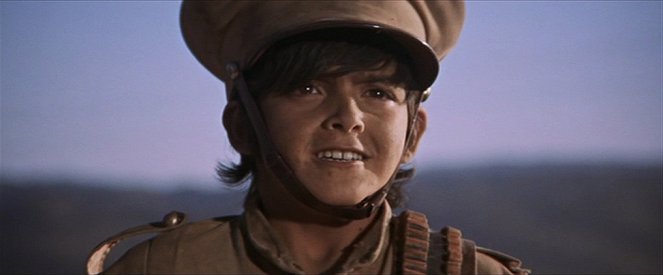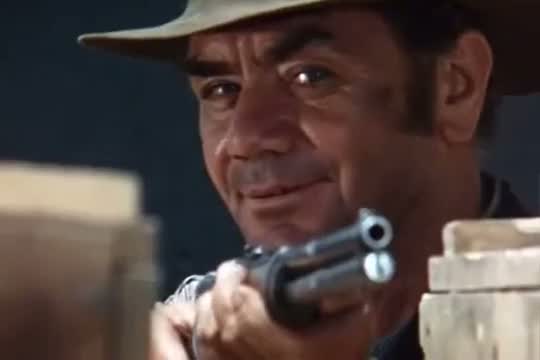Directed by:
Sam PeckinpahCinematography:
Lucien BallardComposer:
Jerry FieldingCast:
William Holden, Ernest Borgnine, Robert Ryan, Edmond O'Brien, Warren Oates, Ben Johnson, Alfonso Arau, Strother Martin, L.Q. Jones, Albert Dekker, Bo Hopkins (more)Plots(1)
In 1913, a gang of outlaws (William Holden, Ernest Borgnine and Robert Ryan, amongst others) ride into a Texan border town where the railroad office is their target. The robbery turns into a blood-bath so the gang flee to a desert hideout where they discover that their loot is worthless. With the railroad company's hired guns snapping at their heels, they decide to escape to the apparent safety of the Mexican revolutionaries. (Warner Bros. Home Entertainment)
(more)Videos (1)
Reviews (9)
A bloody masterpiece with several powerful scenes. In my opinion, stealing the weapons from the train is slightly better than simply a destructive finale. The setting, shortly before the outbreak of the world war, gives it the necessary feeling of the end of the Wild West as we know it, and the beginning of a new era.
()
It's a good western, no doubt about it. It's incredibly bloody, incredibly action-packed, incredibly tough, but I simply found that Sergio Leone and his approach to the western suited me more. The Italian is more American, more emotional, and more Western than the Americans themselves. Here, it is very much influenced by the Mexican setting of a large part of the plot. But as I said, it's an excellent western, it just didn't resonate with me as much as "Once Upon a Time in the West."
()
For everything that happened after the train robbery, I would be delighted to give Peckinpah’s most famous picture full marks and I would also gladly place the Wild Bunch on the pedestal of best westerns right behind Leone’s masterpieces. But I can’t, I just can’t. What prevents me doing so it the hour it takes to get going. It’s not bad, but it is so desperately ordinary and confusable with any other western (with the exception of the opening sequence, of course) that it’s hard to watch.
()
Plenty of dead civilians as an inevitable part of a harsh life; men who only use the word "law" when it suits them; a woman as a symbol of a man's mere distraction... Sam Peckinpah had balls like no other director before or since, and the male superiority simply oozes out of his films. Yet it is a superiority that's honest, uncompromising, and harsh at the same time. This ensures that it can only be seen as an expression of an unmistakable creative genius, one that puts an almost mystical equivalence between the words violence and art and expands the film western to indescribable greatness.
()
It is a bit paradoxical that the only film in Sam Peckinpah's filmography that I have a major problem with is the one that definitively captured the attention of film critics and audience interest. The Wild Bunch once fascinated people with its bloody violence (according to comments on FilmBooster, it still captivates many today, even though the standards have shifted and we are much more desensitized). Journalists tended to consider Peckinpah's film an artistic reflection of the Vietnam War or the rise of violent crime in American cities. Peckinpah, however, rejected one of the important genre rules. A classic western usually works with polarized black-and-white characters, where the positive hero faces villains. In The Wild Bunch, you will find exclusively more or less dirty characters, mostly driven by base motives. The director justified the behavior of his characters with instincts and animality, but this explanation lacks logic. Instincts have their own laws, and they function based on the need for defense, reproduction, acquiring food, and so on. The outbursts of violence in The Wild Bunch defy logical explanation. It is not about the film hero knowing less than the viewer and having only a fraction of the time for crucial decisions. The aggression in the film is actually built on effect, and the characters' decision-making is contrary to their interests and often even natural instincts. At the same time, I was disturbed by the use of humorous relieving elements. The film is strangely inconsistent in its pace, mood, and expressive means. On the other hand, Peckinpah is undoubtedly strong in his visual style with the slow motion technique and careful editing. Moreover, he utilizes the traditional advantages of westerns, expertly enchanting with panoramic shots of the beautiful and wild landscapes of the American Southwest. But sadly, this one won't be getting more than 2 stars from me. Overall impression: 45%.
()
Gallery (196)
Photo © Warner Bros.



Ads